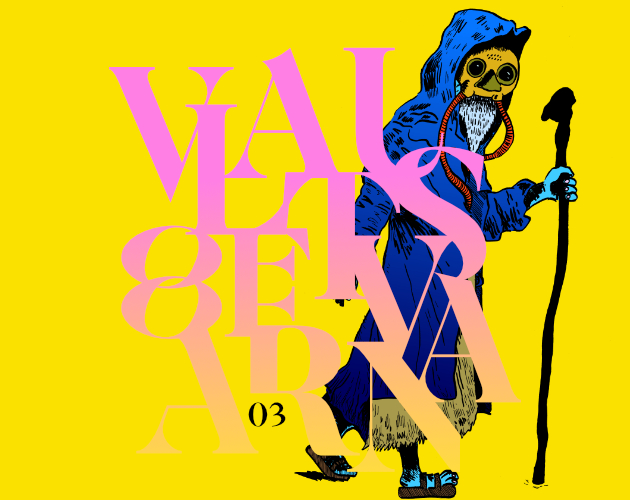Vaults of Vaarn – Leo Hunt ~2022
The following table tells you most of what you need to know about Vaults of Vaarn, an indie TTRPG released in limited edition hard back in 2022-23.
The underlying chassis of the game is Ben Milton's Knave rule set, a riff
on D&D basic and modern gutted down to 7 pages of tables and a core system.
My general view with short page count games is you get what you include pages
for. You can strip down the rules but situations that occur regularly in game will
need to be bridged by the GM and players. In short I think the modern trend of ultra-light
games is with a few exceptions ill judged. Vaults of Vaarn is an exception for
two reasons.
First it is loaded with great tables. Tables that bring its dying earth
Vancian, Wolfe-ian setting to life more than any pages of background or lore
could (why do people like lore so much?). Long-time RPG fans might say this
looks like Gamma World, or even Metamorphosis Alpha, and they would have a
point. This is Sci-fantasy distant future post-apocalypse, but the cultural
touch stones are different. Those 70s-80s games drew from trade paperbacks like
Hiero’s Journey, films such as the Omega-Man, and nuclear paranoia of the era.
Vaults of Vaarn leans more into the dying earth genre in some ways feeling more
reminiscent of Dark Sun. It also references Dune and apes the excellent video
game Caves of Qud. It has a western – eastern feel with wandering swordsmen and
sharp shooters in an alien blue desert littered with ancient ruins and artefacts.
Back to the tables, there are a lot of them. They flesh out the character
generation, gear and special abilities but also factions such as the Faa
Nomads, and bounty hunters. They cover locales, ruins, archaeologies, camps,
and ancient archives. These are practical tables, the kind you could use to
generate sessions on the fly with a bit of experience. They are very evocative tables that yield funny and immersive results. I could roll up an arcology dome populated by warlike amnesiac clones with a surplus of books but a lack of children, or ruined bathhouse converted into a brothel but also used for a Titan shrine.
This brings me to my second point, this is actually a complete and
substantial game. Most modern indie stripped down RPGs (OSR?) leave most of the
work to the GM and bring very little to the table. The old D&D clones avoid
this error, as TSR knew how to construct a game back in the 70s & 80s, as
do some savant designers such as Kevin Crawford with his Stars Without Number
games. Vaults of Vaarn gives me subsystems for most game situations, hiring
NPCs, fighting NPCs, travelling, reaction rolls etc. It is a little lacking in
this area, the games economy is hand waved as a barter based system. In worldwhere water scarcity is a key driver and equipment slots are at a premium a
basic table of equipment values against a standardised currency would help a
lot. Equally there is no bespoke stealth system or henchmen loyalty. Classic
D&D systems such as listening at doors and spotting changes in the dungeon
environment are also gone. Much of this can be done with the general die
rolling mechanic but a lack of guidance in this area is a miss.
The book rounds off with a city setting which leans heavily into Dune
and a couple of mini tomb raid adventures. These are fine and I would consider
using them, but they are not the strongest material I have ever seen.
Physically the deluxe hard back edition is a nice book. It has thick
textured covers and decent amateur Moebius esc art that has become popular in
recent years and good quality paper.
This gets a strong recommendation from me. I suspect the hardback edition will
sell out and have gaps between prints due to its small press nature. The game
originally released as a series of zines that are either free or very cheap in
pdf from online retailers.


Sounds like a fun game- the mix of influences is all pretty much what I like. If you ever run a game I'd be interested in playing.
ReplyDeleteCheers,
Pete.